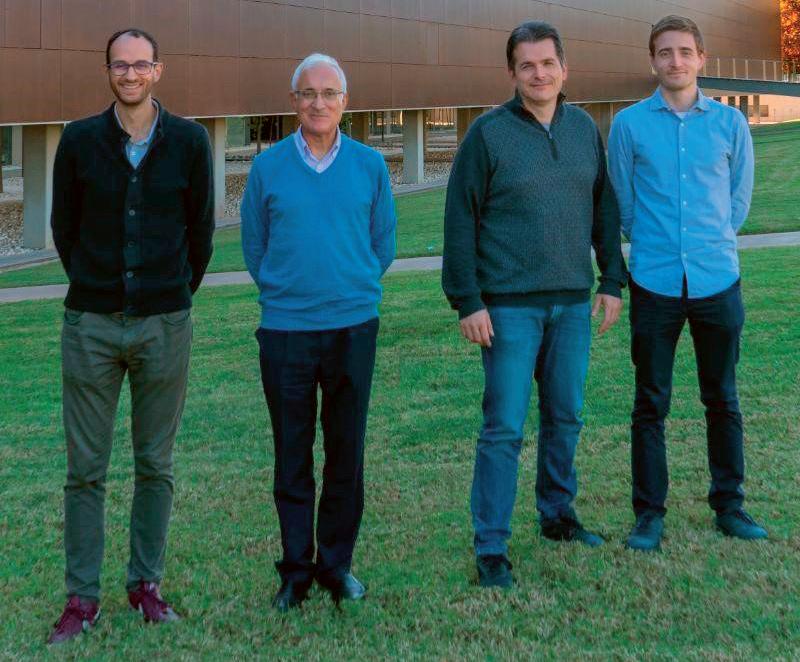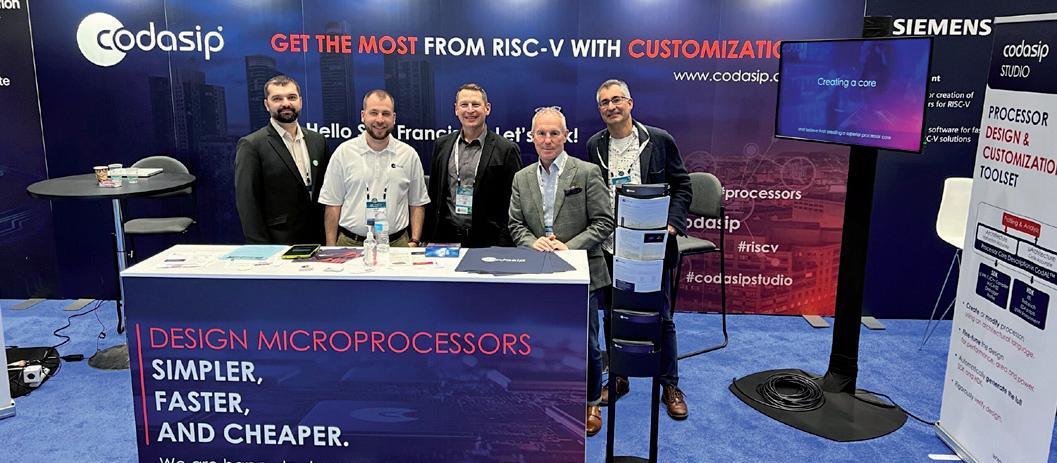5 minute read
Special feature: Reaching for the stars
from HiPEACinfo 65
by HiPEAC
Next Article
RISC-ing it all: How De-RISC is creating the first fully European platform for space
Imagine a market-ready, made-in-Europe hardware-software platform for space and aeronautical applications – free from export restrictions, built on open-source technology, with all the performance of multicore processors and the fault tolerance necessary to withstand the harshest conditions. For the last two years, as reported in HiPEACinfo 59 and 61, the De-RISC consortium has been working to make this a reality. We caught up with the partners behind the research to get the latest on how De-RISC is crossing new frontiers in space technology.

The hypervisor experts: Vicente Nicolau, Paco Gómez, Miguel Masmano, and Antonio GarcíaVilanova (fentISS, De-RISC coordinator)
Why is De-RISC pioneering? The De-RISC RISC-V platform responds to the space sector’s need for higher performance than that provided by the monocore and basic multicore space-grade processors currently on the market. It will allow access to an increasingly rich software ecosystem as an alternative to the existing software based on SPARC, as well as freedom (or drastic reduction) from export restrictions imposed by commercial instruction set architectures (ISAs). De-RISC will also provide improved support for the design and validation of safetyrelated real-time applications, and the platform is developed in accordance with space industry development standards. What makes the XtratuM hypervisor pivotal to the success of De-RISC? Currently, fentISS’ XtratuM is the most popular hypervisor for European space missions. XtratuM guarantees the spatial and temporal isolation required for space safety-related real-time systems, thus allowing the efficient deployment of mixed-criticality applications. XtratuM has already been deployed in 360 satellites of three different missions already in space and it will be used as part of a number of NewSpace and conventional missions to be launched over the next five years.

What is fentISS contributing to the project? fentISS ported the hypervisor XtratuM to the RISC-V architecture hardware platform of the project, as well as the ARINC-653 compatible LithOS runtime. The supporting tools for developing XtratuM-based systems over the hardware platform have also been developed, and fentISS has led the definition of the software requirements of the platform. Currently, we are implementing support for full virtualization of the Xtratum-Next Generation (XNG) hypervisor in the scope of RISC-V, while next year we will focus on hypervisor validation.
How do you foresee De-RISC technology being used after the project finishes? The De-RISC ambition is to become European leaders in the supply of an integrated modular avionics (IMA) hardware and software platform, offering users the opportunity to migrate their applications to the RISC-V open-source ISA, being suitable for the avionics domain in addition to the space domain. This technology will be increasingly adopted in space and aircraft systems over the next few years.
The applications dream team: Jérôme Quévremont, Laurent Corbin and Jimmy Le Rhun, Thales Research & Technology
What kind of applications will De-RISC technology be used for? The De-RISC platform is primarily designed to fulfil the requirements of space systems. It features fault-tolerant mechanisms at every level of the platform, integrates dedicated space-grade input / output (I/O) interfaces, and will be radiation tested to representative orbital conditions in the project. However, the high flexibility of a field-programmable gate array (FPGA) implementation and the dependability features of the platform also make it well suited for all kinds of embedded, real-time, safetycritical and mission-critical systems. What is Thales’ contribution to the project? Thales was responsible for the definition of requirements at the beginning of the project, and performs the end-user validation of the platform. To do so, we are working on several software use-cases, from number-crunching benchmarks to evaluate the raw performance up to a representative satellite payload software. For the latter we partnered with CNES, the French space agency, to use their generic payload flight software framework, LVCUGEN.
Why is De-RISC technology important for Thales? An important aspect for Thales is the openness of the RISC-V architecture, which allows the implementation of dependability mechanisms not usually found in commercial off-the-shelf (COTS) multicore processors, such as the reduction of timing interference channels, better management of shared resources and advanced monitoring. Independence from export restrictions is another important property, ensured by the exclusively European development of the De-RISC platform.
The hardware pioneers: Stefano Ribes, Fabio Malatesta, and Jan Andersson, Cobham Gaisler
What is Cobham Gaisler’s role in the project? Why is De-RISC important for the company? We provide the hardware platform for De-RISC. The peripherals used in the system-on-chip design are reused from our library of intellectual property (IP) controllers and we apply our NOEL-V RISC-V processor in a RV64GCH configuration in the platform. We already apply a hardware / software co-design methodology for our developments, but De-RISC has allowed us to include external parties in this process. The project provides a framework for us to work with a software vendor, an end user and an academic partner, and we are therefore able to adapt the hardware building blocks to the needs of project partners. The hypervisor software contribution from fentISS is also important for us and beneficial for the whole RISC-V community.

How would you like to see De-RISC technology being used? The NOEL-V platform has already been adopted for an on-board computer product by an external company. We hope to see this trend continue and we are also applying the technology developed in our nextgeneration standard product as part of a European Space Agency project. The multicore maestros: Jaume Abella, Sergi Alcaide and Guillem Cabo, Barcelona Supercomputing Center
What is BSC’s contribution to this project? Our contribution includes: • An extended statistics unit, named SafeSU, which provides capabilities to diagnose and control multicore timing interference, and to implement safety measures on top. • Performance validation stressing tests, mostly targeting multicore interference scenarios. • Cross-domain analysis of the suitability of the De-RISC platform. All three items build on previous technology and know-how developed by BSC in the scope of other H2020/FP7 projects and ESA-funded projects, whose target technology readiness level (TRL) was generally lower than that of De-RISC.
Why are multicore processing capabilities important for space applications? Performance demands are constantly growing in response to the needs of increasing automation and system autonomy. This entails higher performance needs for individual functionalities, as well as a larger number of software functionalities needing to be consolidated onto a limited number of platforms.
Why is interference mitigation particularly important for space applications? Some safety-critical and mission-critical applications, such as those related to the integrity of the spacecraft (safety-critical) and to the mission instruments (mission-critical) have real-time requirements. However, hardware components inside the processor and in the board cannot be replicated due to costs and reliability concerns. Hence, sharing is mandatory, but the impact of sharing on timing must be properly managed to ensure that safety- and mission-critical applications execute in a timely manner.

